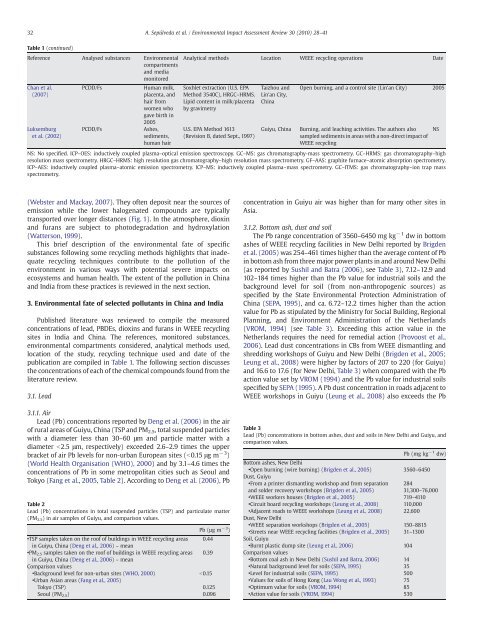A review of the environmental fate and effects of hazardous ...
A review of the environmental fate and effects of hazardous ...
A review of the environmental fate and effects of hazardous ...
Create successful ePaper yourself
Turn your PDF publications into a flip-book with our unique Google optimized e-Paper software.
32 A. Sepúlveda et al. / Environmental Impact Assessment Review 30 (2010) 28–41Table 1 (continued)Reference Analysed substances Environmentalcompartments<strong>and</strong> mediamonitoredAnalytical methods Location WEEE recycling operations DateChan et al.(2007)Luksemburget al. (2002)PCDD/FsPCDD/FsHuman milk,placenta, <strong>and</strong>hair fromwomen whogave birth in2005Ashes,sediments,human hairSoxhlet extraction (U.S. EPAMethod 3540C), HRGC–HRMS.Lipid content in milk/placentaby gravimetryU.S. EPA Method 1613(Revision B, dated Sept., 1997)Taizhou <strong>and</strong>Lin'an City,ChinaGuiyu, ChinaOpen burning, <strong>and</strong> a control site (Lin'an City) 2005Burning, acid leaching activities. The authors alsosampled sediments in areas with a non-direct impact <strong>of</strong>WEEE recyclingNS: No specified. ICP–OES: inductively coupled plasma–optical emission spectroscopy. GC–MS: gas chromatography-mass spectrometry. GC–HRMS: gas chromatography–highresolution mass spectrometry. HRGC–HRMS: high resolution gas chromatography–high resolution mass spectrometry. GF–AAS: graphite furnace–atomic absorption spectrometry.ICP–AES: inductively coupled plasma–atomic emission spectrometry. ICP–MS: inductively coupled plasma–mass spectrometry. GC–ITMS: gas chromatography–ion trap massspectrometry.NS(Webster <strong>and</strong> Mackay, 2007). They <strong>of</strong>ten deposit near <strong>the</strong> sources <strong>of</strong>emission while <strong>the</strong> lower halogenated compounds are typicallytransported over longer distances (Fig. 1). In <strong>the</strong> atmosphere, dioxin<strong>and</strong> furans are subject to photodegradation <strong>and</strong> hydroxylation(Watterson, 1999).This brief description <strong>of</strong> <strong>the</strong> <strong>environmental</strong> <strong>fate</strong> <strong>of</strong> specificsubstances following some recycling methods highlights that inadequaterecycling techniques contribute to <strong>the</strong> pollution <strong>of</strong> <strong>the</strong>environment in various ways with potential severe impacts onecosystems <strong>and</strong> human health. The extent <strong>of</strong> <strong>the</strong> pollution in China<strong>and</strong> India from <strong>the</strong>se practices is <strong>review</strong>ed in <strong>the</strong> next section.3. Environmental <strong>fate</strong> <strong>of</strong> selected pollutants in China <strong>and</strong> IndiaPublished literature was <strong>review</strong>ed to compile <strong>the</strong> measuredconcentrations <strong>of</strong> lead, PBDEs, dioxins <strong>and</strong> furans in WEEE recyclingsites in India <strong>and</strong> China. The references, monitored substances,<strong>environmental</strong> compartments considered, analytical methods used,location <strong>of</strong> <strong>the</strong> study, recycling technique used <strong>and</strong> date <strong>of</strong> <strong>the</strong>publication are compiled in Table 1. The following section discusses<strong>the</strong> concentrations <strong>of</strong> each <strong>of</strong> <strong>the</strong> chemical compounds found from <strong>the</strong>literature <strong>review</strong>.3.1. Lead3.1.1. AirLead (Pb) concentrations reported by Deng et al. (2006) in <strong>the</strong> air<strong>of</strong> rural areas <strong>of</strong> Guiyu, China (TSP <strong>and</strong> PM 2.5 , total suspended particleswith a diameter less than 30–60 μm <strong>and</strong> particle matter with adiameter b2.5 μm, respectively) exceeded 2.6–2.9 times <strong>the</strong> upperbracket <strong>of</strong> air Pb levels for non-urban European sites (b0.15 μg m − 3 )(World Health Organisation (WHO), 2000) <strong>and</strong> by 3.1–4.6 times <strong>the</strong>concentrations <strong>of</strong> Pb in some metropolitan cities such as Seoul <strong>and</strong>Tokyo (Fang et al., 2005, Table 2). According to Deng et al. (2006), PbTable 2Lead (Pb) concentrations in total suspended particles (TSP) <strong>and</strong> particulate matter(PM 2.5 ) in air samples <strong>of</strong> Guiyu, <strong>and</strong> comparison values.Pb (µg m − 3 )•TSP samples taken on <strong>the</strong> ro<strong>of</strong> <strong>of</strong> buildings in WEEE recycling areas 0.44in Guiyu, China (Deng et al., 2006) – mean•PM 2.5 samples taken on <strong>the</strong> ro<strong>of</strong> <strong>of</strong> buildings in WEEE recycling areas 0.39in Guiyu, China (Deng et al., 2006) – meanComparison values•Background level for non-urban sites (WHO, 2000) b0.15•Urban Asian areas (Fang et al., 2005)Tokyo (TSP) 0.125Seoul (PM 2.5 ) 0.096concentration in Guiyu air was higher than for many o<strong>the</strong>r sites inAsia.3.1.2. Bottom ash, dust <strong>and</strong> soilThe Pb range concentration <strong>of</strong> 3560–6450 mg kg − 1 dw in bottomashes <strong>of</strong> WEEE recycling facilities in New Delhi reported by Brigdenet al. (2005) was 254–461 times higher than <strong>the</strong> average content <strong>of</strong> Pbin bottom ash from three major power plants in <strong>and</strong> around New Delhi(as reported by Sushil <strong>and</strong> Batra (2006), see Table 3), 7.12–12.9 <strong>and</strong>102–184 times higher than <strong>the</strong> Pb value for industrial soils <strong>and</strong> <strong>the</strong>background level for soil (from non-anthropogenic sources) asspecified by <strong>the</strong> State Environmental Protection Administration <strong>of</strong>China (SEPA, 1995), <strong>and</strong> ca. 6.72–12.2 times higher than <strong>the</strong> actionvalue for Pb as stipulated by <strong>the</strong> Ministry for Social Building, RegionalPlanning, <strong>and</strong> Environment Administration <strong>of</strong> <strong>the</strong> Ne<strong>the</strong>rl<strong>and</strong>s(VROM, 1994) (see Table 3). Exceeding this action value in <strong>the</strong>Ne<strong>the</strong>rl<strong>and</strong>s requires <strong>the</strong> need for remedial action (Provoost et al.,2006). Lead dust concentrations in CBs from WEEE dismantling <strong>and</strong>shredding workshops <strong>of</strong> Guiyu <strong>and</strong> New Delhi (Brigden et al., 2005;Leung et al., 2008) were higher by factors <strong>of</strong> 207 to 220 (for Guiyu)<strong>and</strong> 16.6 to 17.6 (for New Delhi, Table 3) when compared with <strong>the</strong> Pbaction value set by VROM (1994) <strong>and</strong> <strong>the</strong> Pb value for industrial soilsspecified by SEPA (1995). A Pb dust concentration in roads adjacent toWEEE workshops in Guiyu (Leung et al., 2008) also exceeds <strong>the</strong> PbTable 3Lead (Pb) concentrations in bottom ashes, dust <strong>and</strong> soils in New Delhi <strong>and</strong> Guiyu, <strong>and</strong>comparison values.Pb (mg kg − 1 dw)Bottom ashes, New Delhi•Open burning (wire burning) (Brigden et al., 2005) 3560–6450Dust, Guiyu•From a printer dismantling workshop <strong>and</strong> from separation<strong>and</strong> solder recovery workshops (Brigden et al., 2005)28431,300–76,000•WEEE workers houses (Brigden et al., 2005) 719–4110•Circuit board recycling workshops (Leung et al., 2008) 110,000•Adjacent roads to WEEE workshops (Leung et al., 2008) 22,600Dust, New Delhi•WEEE separation workshops (Brigden et al., 2005) 150–8815•Streets near WEEE recycling facilities (Brigden et al., 2005) 31–1300Soil, Guiyu•Burnt plastic dump site (Leung et al., 2006) 104Comparison values•Bottom coal ash in New Delhi (Sushil <strong>and</strong> Batra, 2006) 14•Natural background level for soils (SEPA, 1995) 35•Level for industrial soils (SEPA, 1995) 500•Values for soils <strong>of</strong> Hong Kong (Lau Wong et al., 1993) 75•Optimum value for soils (VROM, 1994) 85•Action value for soils (VROM, 1994) 530
















